CHICAGO & NORTH WESTERN RAILROAD LANTERN A&W CO. ADLAKE RELIABLE C&NW. Ry 1897
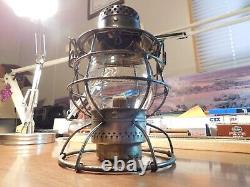
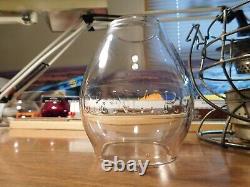
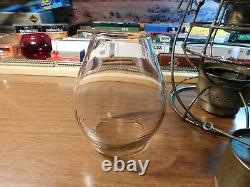
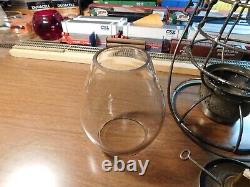
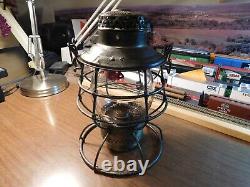
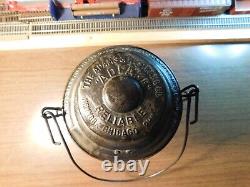
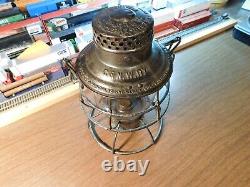
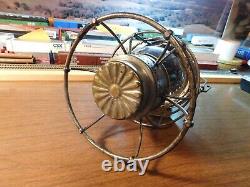

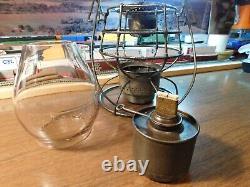
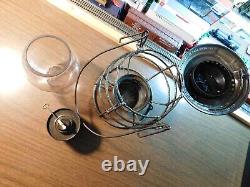
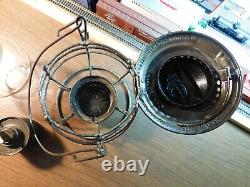
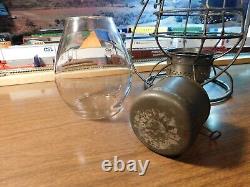
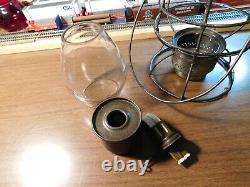


CHICAGO & NORTH WESTERN RAILWAY. This is a Vintage piece of Railroad History made by The Adams & Westlake Company for the CHICAGO & NORTHWESTERN RAILROAD. The double wire frame is marked THE ADAMS & WESTLAKE CO. 21, 1897, last date JULY.
The Brass burner is marked ADLAKE PAT. 27,1909, burner and fount are in good working condition. The cast clear glass globe is embossed C. No cracks, some cast marks, bubble and some small flea chips around rims.
Frame has been sprayed with clear coat. Chicago and North Western Transportation Company. From Wikipedia, the free encyclopedia. For other uses, see CNW (disambiguation). Map of the Chicago and North Western Railway.
Black lines are trackage now owned by the Union Pacific Railroad. Green lines are owned by the Dakota, Minnesota and Eastern Railroad. Blue lines are owned by other railroads, and dotted lines are abandoned.4408, travels through Niagara, Wisconsin. Some trackage in Wisconsin is now operated by the Wisconsin and Southern Railroad.
The Chicago and North Western reporting mark. CNW was a Class I railroad. In the Midwestern United States. It was also known as the "North Western". The railroad operated more than 5,000 miles (8,000 km) of track at the turn of the 20th century, and over 12,000 miles (19,000 km) of track in seven states before retrenchment. The C&NW became one of the longest railroads in the United States as a result of mergers with other railroads, such as the Chicago Great Western Railway. By 1995, track sales and abandonment had reduced the total mileage to about 5,000. Large line sales, such as those that resulted in the Dakota, Minnesota and Eastern Railroad. Further helped reduce the railroad to a mainline core with several regional feeders and branches.Paul and Fond du Lac Railroad. On February 15, 1865, it merged with the Galena and Chicago Union Railroad. Which had been chartered on January 16, 1836. Since the Galena & Chicago Union started operating in December 1848, and the Fond du Lac railroad started in March 1855, the Galena and Chicago Union Railroad is considered to be the origin of the North Western railroad system. Other lines acquired and added to the network included the Chicago, St.
In 1859, the Winona and St. In 1867, the Chicago, Milwaukee and North Western Railway. In 1883, the Sioux City and Pacific Railroad. In 1880, the Fremont, Elkhorn and Missouri Valley Railroad. In 1884, and the Milwaukee, Lake Shore and Western Railway.
They also held extensive property in Michigan, particularly its Upper Peninsula. To the point where they were one of the largest property owners in the state. Changing traffic patterns and competition with automobiles and trucking disrupted the railroad's profitability by mid-20th century. After nine years in bankruptcy, the C.
It had turned rapidly to diesel power, and established a huge diesel shop in Chicago. Potatoes from the west were a main crop loading of the C. And its potato sheds in Chicago were the nation's largest. It also carried western sugar beets.
And huge amounts of corn and wheat. This road, like other lines depending strongly on transportation of crops, was adversely affected by government agricultural credit policies which sealed a lot of products on the farms where they were produced.
Although it stood sixteenth in operating revenue in 1938, it was eighth in passenger revenue among American railroads. It served Chicago commuters; its 400 streamliners provided intercity transportation, and it provided an eastern link to bring the Union Pacific. S passengers from Omaha, Nebraska.
And points west to Chicago. The North Western had owned a majority of the stock of the Chicago, St. Paul, Minneapolis and Omaha Railway. On January 1, 1957, it leased the company, and merged it into the North Western in 1972.
The Omaha Road's main line extended from an interchange with the North Western at Elroy, Wisconsin. To the Twin Cities, south to Sioux City, Iowa.
And then finally to Omaha, Nebraska. The North Western acquired several important short railroads during its later years.
It completed acquisition of the Litchfield and Madison Railway. The Litchfield and Madison railroad was a 44-mile (71 km) bridge road from East St. On July 30, 1968, the North Western acquired two former interurbans - the 36-mile (58 km) Des Moines and Central Iowa Railway. (DM&CI), and the 110-mile (180 km) Fort Dodge, Des Moines and Southern Railway.
The DM&CI gave access to the Firestone plant in Des Moines, Iowa. And the FDDM&S provided access to gypsum mills in Fort Dodge, Iowa. On November 1, 1960, the North Western acquired the rail properties of the 1,500-mile (2,400 km) Minneapolis and St. In spite of its name, it ran only from Minneapolis, Minnesota. This acquisition provided traffic and modern rolling stock, and eliminated competition.


